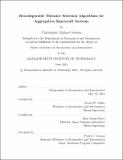Reconfigurable thruster selection algorithms for aggregative spacecraft systems
Author(s)
Jewison, Christopher Michael
DownloadFull printable version (8.294Mb)
Other Contributors
Massachusetts Institute of Technology. Department of Aeronautics and Astronautics.
Advisor
David W. Miller and Alvar Saenz-Otero.
Terms of use
Metadata
Show full item recordAbstract
The vast majority of today's space systems launch to orbit as completely assembled spacecraft stowed within a single launch vehicle. However, there is demand for large space systems (e.g., large space telescopes, fuel depots, space habitats, and solar power stations) that are overly limited by the lifting capability and fairing size of one launch vehicle. By separating large space systems into modules on multiple launches, these restrictions can be lifted, given a method to assemble and recongure the modules once on orbit. Specific control challenges associated with this reconguration need to be overcome before on-orbit assembly can be proven to be cost and resource eective. Some of these challenges have been addressed through adaptive and robust controller design, however an area that has not been explored deeply enough is that of thruster selection algorithms. In spacecraft control, thruster selection algorithms determine which thrusters to re to produce a commanded force or torque on the system. Thus, these algorithms are critical for implementation of new controllers. To solve some of the control challenges associated with a system gaining additional thrusters, the goal of a recongurable thruster selection algorithm is to adapt to the new mass properties and thruster layout of the aggregated spacecraft, while optimizing for fuel consumption, precision, and agility. In this thesis, the proposed methodology is presented. A simulation for testing these algorithms is described, and results detailing the success of these recongurable thruster selection algorithms are discussed. In addition, results from preliminary testing of these algorithms using the MIT Synchronized Position Hold, Engage, Reorient, Experimental Satellites (SPHERES) facility in the three degree-of-freedom ground testbed are reported.
Description
Thesis: S.M., Massachusetts Institute of Technology, Department of Aeronautics and Astronautics, 2014. This electronic version was submitted by the student author. The certified thesis is available in the Institute Archives and Special Collections. Cataloged from student-submitted PDF version of thesis. Includes bibliographical references (pages 167-170).
Date issued
2014Department
Massachusetts Institute of Technology. Department of Aeronautics and AstronauticsPublisher
Massachusetts Institute of Technology
Keywords
Aeronautics and Astronautics.